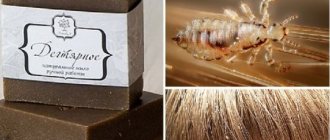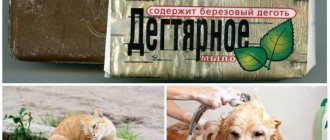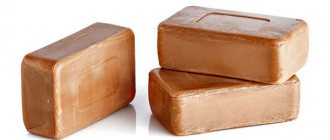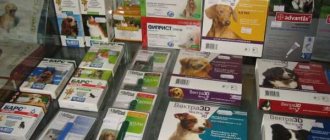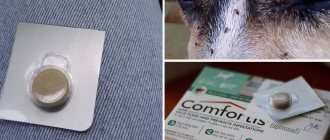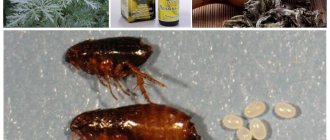What it is?
Soap with tar is indeed successfully used as a cosmetic and medical product. It can treat dermatitis and skin rashes.
Under its influence, wounds, cracks and scratches on the skin heal faster - this happens because birch tar (the main component of soap) promotes epithelial regeneration . Hair washed with it begins to shine and falls out less. It is also indicated for pediculosis.
Yes, at first tar soap was considered as a remedy to relieve the itching from lice bites.
It did not work as a remedy against most pests. But the tradition of washing your hair with it when lice appear has created a myth about its healing properties , which has acquired new details: tar soap poisons not only lice, but also fleas and even destroys ticks!
To understand how true this information is, it is worth knowing how the components of tar soap affect parasites.
Benefits of tar soap
Unlike chemical veterinary preparations, tar soap does not contain poisons, toxins, or other compounds and substances potentially harmful to the animal’s body, does not dry out the skin of animals, and has a beneficial effect on the coat.
Tar soap can be used for bathing animals if the skin has wounds, microcracks, skin rashes, small scratches, or other visible damage to the dermis. Veterinarians recommend using this product for the prevention of dermatitis, dermatoses, and skin infections of fungal etiology. The components of the natural product have a beneficial effect on all structures of the epidermis, have a mild analgesic, drying, and tonic effect.
To combat fleas, tar soap can be used regularly for bathing small kittens, starting from 5-7 weeks of age. Note that insecticidal-acaricidal drops can be used for therapeutic and preventive treatments of animal hair only from two months of age.
Tar soap does not cause side effects. Allergies, urticaria, skin rash, and other uncharacteristic symptoms are noted only in the case of individual intolerance by the animal body to the components of the natural remedy.
In addition, tar soap has an affordable price and can be purchased at any pharmacy in the city.
The bathing procedure using tar soap is carried out in the following sequence:
- Soften a small piece of soap in warm water.
- Lather it until you get a lot of foam.
- Wet your pet's fur well. Make sure that water does not get into the ears.
- Apply foam to the fur, then rub the cat’s body with a softened piece of soap.
- While holding the cat in the bathtub or basin, do not rinse off the foam for 5-10 minutes. For greater effectiveness, wrap the soaped animal in a terry towel. Make sure that soap foam does not get on the mucous membranes or in the oral cavity.
After the procedure, rinse the soap from your pet's fur with plenty of warm water. After bathing, wrap your cat in a towel. Part the fur in favorite areas where fleas hang out. Remove dead insects by hand. After the fur is dry, comb your pet well with a fine comb or brush.
As already noted, despite all the advantages of an available natural remedy, for the treatment of entomosis in cats in advanced stages, it is best to use special insectoacaricidal agents, which can be purchased at pet stores, veterinary clinics, and veterinary pharmacies.
From this article you will learn:
Tar soap
Composition and effects
Tar soap looks like dark brown bars, opaque, with a sharp, tart odor. Many people find it unpleasant, but some people like it. Main components of soap:
- Birch tar – soap can contain up to 10%. It is produced by squeezing the extract obtained from birch. It is this that gives the product its specific smell and is also famous for its medicinal properties. Tar is used to produce not only soap, but also a number of medicines, for example, Vishnevsky ointment for the treatment of wounds, burns and suppurations. This element can really help against fleas:
- Its very smell has a depressing effect on parasites - they rush to get away from it. Insects are sensitive to odors. Through them they find food and a mate for mating. The overly strong smell has a disorienting effect.
- Tar contains benzene , which paralyzes the nerve centers of insects. They will not die, but will become lethargic and begin to move chaotically. This will make them easier to detect and comb out.
- Sodium salts. They are beneficial for the skin because they normalize its water-salt balance and protect it from excessive evaporation of moisture. This property is also very important for the delicate skin of a dog.
- Phenol and alkali. They affect insects, causing them direct harm - burns. However, they are not capable of destroying them: the bodies of lice and even their eggs are protected by a durable shell. But the microbes will die after such washing.
It may also contain citric acid, Diethylene Glycol (thickener), sodium chloride, palm oil and water. The composition of tar soap varies depending on the manufacturer , but this is not so important, because the main component - tar - remains unchanged.
IMPORTANT: Diethylene Glycol (thickener) can be harmful if ingested.
Therefore, if you decide to wash your pet with tar soap, make sure that he does not swallow the foam.
Can it be used to protect against fleas?
Tar soap cannot be considered a complete insecticide. But it can still bring some benefit: it won’t kill, but it will repel fleas . At the same time, special products for animals will solve the problem faster and more reliably.
Whether or not to wash a dog with it is up to each animal owner to decide for himself. To make it easier for you to make this choice, we list the main advantages and disadvantages .
pros
- Tar soap boasts a natural composition , which most special shampoos do not have.
- Does not cause allergies , does not penetrate into the blood and milk. You can absolutely safely use it when washing puppies (after 1 week of life) and pregnant dogs.
- There are no side effects - no nausea, no vomiting, no loss of appetite or lethargy, no changes in behavior. You also don’t have to worry about rashes (which can’t be said about special shampoos).
- You can wash your dog with tar soap not only for small abrasions and scratches, but even for open wounds , eczema or dermatitis.
- Maintains normal salt-water balance of the skin, but special shampoos for dogs can dry out the skin.
- Can be used as often as needed without harming the dog's health.
- Inexpensive product (again, compared to special products).
- Safe for humans and convenient to use.
REFERENCE: allergies to tar almost never happen. Other components of the product - thickeners and preservatives - can cause irritation, but in this case it is enough to change the brand of soap.
Minuses
- As already mentioned, the main effect on insects is the unpleasant smell of tar . Fleeing from it, fleas will escape from the animal, including onto your floors, carpets, sofas and chairs. They will live well there for some time, and when the smell disappears, they will attack the dog again.
- An unpleasant odor affects more than just fleas. The owner and his pet will also have to endure a specific aroma. And you shouldn’t think that it’s enough to endure it once - to get rid of parasites you will have to spend a lot of time and effort . Significantly more than when using special means.
- Soap that gets into your pet's eyes and nose will also not add a pleasant feeling to him: it burns strongly .
- Well, the most important thing: tar soap has no effect on insect eggs . So, soon after the procedure, new parasites will hatch on the dog, which will ruin all your efforts.
So, tar soap will be a real salvation for dogs with allergies, babies, pregnant bitches and those individuals who can be harmed by a special shampoo containing more aggressive substances.
It is absolutely harmless.
Feedback from users
Most owners who have experienced the effect of tar soap for removing fleas from pets confirm the high effectiveness of the product. There are practically no negative reviews, the composition is safe and low-toxic. Cats and dogs tolerate the effects of birch tar and additional soap components well; skin irritation rarely occurs.
The only drawback is that cats do not like to bathe; processing wool turns into a “fight” with your pet. The owner needs to be dexterous and act quickly to bathe Murzik in soapy foam, but avoid deep scratches. Many people recommend removing fleas from cats using the proposed method only with an assistant.
Treating the premises and animal hair with tar soap is a proven folk method of fighting fleas. Tiny biting insects will quickly leave an area with an unpleasant odor. A product based on birch tar quickly destroys and repels blood-sucking parasites, but does not harm people or pets. “Grandma’s” method of removing fleas is effective if you follow the rules for treating animals and premises. Preventive measures are a prerequisite for preventing a re-attack of biting parasites.
Using tar soap you can rid your pet of fleas. How to do it? Watch the following video:
Should they wash an animal with it without parasites?
Soap can also be useful for those animals that do not have any problems with fleas. It is not for nothing that tar is used in shampoos, solving the following problems:
- reduces and even gets rid of dandruff;
- removes soreness of the skin under the hairline;
- reduces hair loss;
- accelerates growth and increases density.
Many women speak of this remedy as miraculous, helping when expensive shampoos have stopped working. Shampoo will have exactly the same effect on your pet’s fur, which is why even today many owners abandon professional dog products in favor of tar soap .
In addition to the positive aspects already described, long-haired breeds will find it easier to comb. And short-haired dogs will be able to boast that their coat becomes thicker and tougher. The most important thing here is not to dry out the coat and skin with too frequent use; otherwise, tar soap will make the dog healthier.
How to bathe your pet?
To begin, prepare :
- leash;
- container for washing if the pet is small;
- bowl for foaming - soap does not foam well;
- flea comb;
- insect collection jar;
- towel.
HELP: tar soap also exists in liquid form, which will make bathing much easier.
Now that everything is ready, you can begin the process :
- Place your pet in the bathtub and tie it to the faucet with a leash.
- Spray your dog with water to get his fur wet. Then lather with a foam solution and rinse the fur, paying special attention to areas on the stomach, chest, and armpits. You definitely need to treat your head! Otherwise, the fleas will move onto it and safely wait out the procedure.
- Rinse the animal. Some of the fleas will already be washed off.
- Repeat the procedure with soaping. After this, the dog should stand for five minutes - during this time the pet should be calmed or entertained.
- Comb out the fleas with a comb - they will make the task easier by jumping out on their own. It is better to collect them in a jar, otherwise they will spread throughout the apartment.
- Rinse off the foam by rinsing your dog several times. The smell of tar will remain, but not for long.
- Go through the fur on the face, behind the ears and on the chin. This way you will destroy a dozen more surviving fleas.
- Dry the animal.
- The procedure will need to be repeated every three days.
Instructions for use
Using tar soap for cats is more difficult than using flea drops. The owner's task is to calm the pet and wash it. It is important to lather the coat thoroughly without leaving any missing areas. This will be impossible if the cat breaks free and tries to run away.
To achieve the goal, you must follow the following algorithm of actions:
- Prepare a bowl of warm water. Place the cat's paws there.
- Moisten the animal's fur generously with water. Care must be taken to ensure that the liquid does not get into the eyes, nose and ears.
- Lather the cat's body with massaging movements.
- Wrap the animal in a thick towel or blanket. You need to keep your pet in this state for 10-15 minutes.
- Rinse off any remaining foam and soap.
- Dry the cat with a towel.
- Dry the pet's fur and comb it with a special flea brush - a comb with fine, fine teeth.
It is better to wash a cat together - one holds the animal, and the second soaps it.
There is one more nuance. If your pet is very nervous during water procedures, then you can reduce contact with liquid to a minimum. Foam from tar soap is rubbed into dry fur and only at the second stage is the cat rinsed with a shower. This method of fighting bloodsuckers is not suitable for long-haired breeds.
Contraindications
There are practically none - natural tar soap is safe even when licking wool after washing. But they, like any drug, should not be abused .
You can use this soap for dogs no more than twice a week; it is advisable not to get carried away with prevention and alternate with something else. Otherwise, the fur will lose its shine and become drier and unruly. In the future, you can even achieve shaggy and shabby hair.
This will also have a negative impact on the skin : there will be a feeling of tightness that will bother the animal.
When you decide to try tar soap on your pet, watch his reaction. If the dog expresses strong dissatisfaction with the smell, there is no need to force it; today there are many other means . If everything is fine, then using environmentally friendly soap will bring exceptional benefits to your pet.
Is room treatment required?
The question of the need to treat a room should be decided individually. This is only advisable if there is a strong infestation or insects have penetrated into the furniture. In most cases, it is enough to wash the pet’s bed and things with a solution of tar soap. You can add a little product to the water for washing floors. This will prevent fleas from moving into the cracks. If parasites have settled in furniture, floors and carpets, professional treatment using toxic insecticidal preparations will be required.
